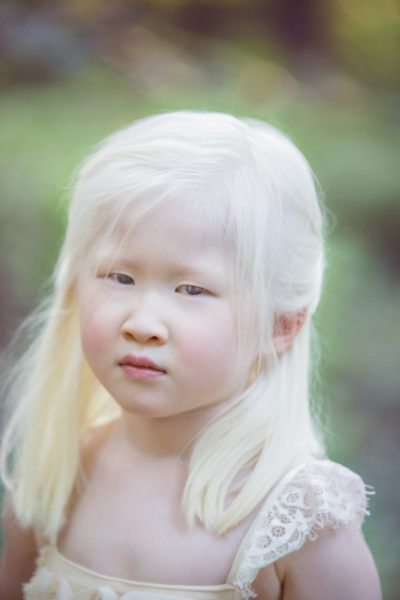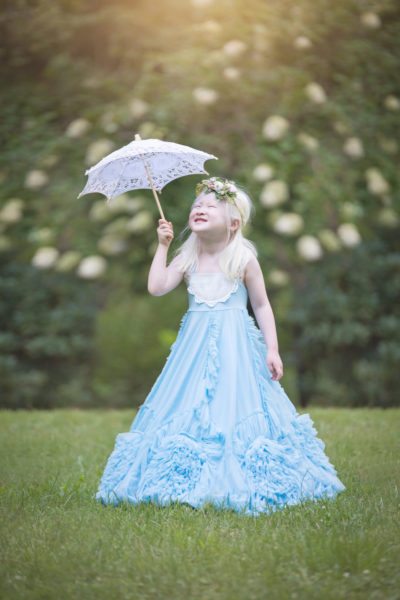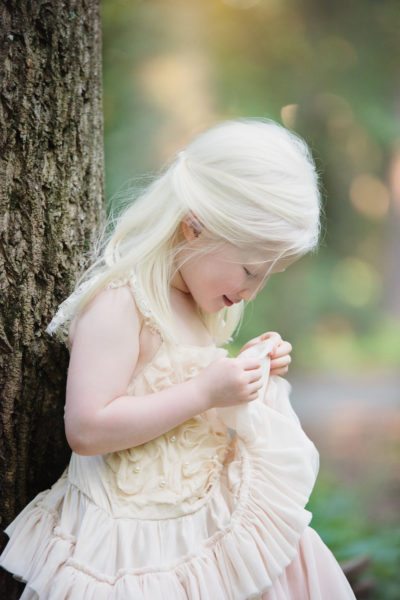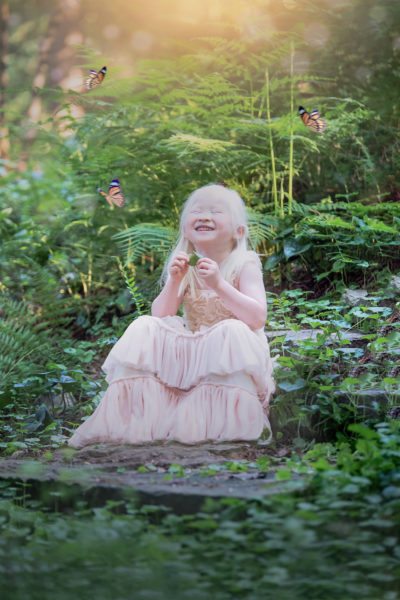Emily loves dolls, dress-up, panda bears, ballet, singing while playing her brother’s ukulele upside down, blowing bubbles, Disney World, soccer, and “preaching” to us from her children’s Bible. She has a quick wit and makes us laugh every day. And, she was born with a condition called albinism.
And that’s really it. Albinism is just one thing about her. It’s not a big thing and it’s certainly not the over-arching thing. It’s just one aspect of what makes her the unique and wonderful person she is.

On a daily basis, albinism isn’t even something we think very much about. The “skin condition” aspects of it have become second nature. It’s almost like putting on a seatbelt when you get in the car. The seatbelt is just a step you take before you turn on the car and get ready to go. The same is true for us with sunscreen. Because we know that people with albinism have a higher risk of skin cancer, applying sunscreen is just one more thing we do – after brushing hair and teeth – before we set out for the day.
We keep the sunscreen in a basket near the door as a reminder and, right after I fix her hair, I supervise her using a sunscreen stick on her face. Sticks are easy and she knows to go from the nose out – like painting stripes – to get full coverage. For now, since she’s four years old, we still handle putting lotion sunscreen on her arms and legs.
At school, her IEP requires her teachers to give her a hat and to help her apply sunscreen every two hours if she will be outside. At the beginning of the school year, we give the teachers a Ziploc bag containing a sunscreen stick (for face), a sunscreen lotion, and a sun hat. The bag also contains sunglasses (although some people just have prescription sunglasses) that she can wear if she chooses. (Her regular glasses darken outside and sometimes, that’s enough). Her afterschool program at a nearby church also has a similar bag filled with the same items (hat and sunscreen and sunglasses) so that those teachers can re-apply sunscreen if the kids go out later in the afternoon.
We go to the beach once or twice each year, we are members of our neighborhood pool, and we love Disney World. The sun doesn’t stop Emily or us. We just have to be smart about it. Sunscreen and hats and sunglasses are the things we use to protect her skin and eyes from the sun. Pretty easy. Pretty routine. And, really, something everybody should be doing for all kids – even those who were not born with a “skin condition” like albinism.

The “bigger” thing for people with albinism is not the skin aspect, though. It is that the same lack of pigment that causes the skin and hair to be white also causes abnormal development of the retina and the nerve connections in the eyes. This abnormal eye development causes vision problems that are not correctable with glasses or surgery. Whenever I see an advocacy post about a baby or child with albinism, I always see posts about how cute or beautiful the child is (and I agree) and then at least one post (and often more) asking ,“Will he have vision problems?” Or “Can she see?” The answer to the first question is that all persons with albinism have some degree of vision impairment. But, the answer to the second question is Yes, they can see. As the NOAH website – a great source of information on albinism) puts it, “The degree of impairment varies with the different types of albinism. Although people with albinism may be considered ‘legally blind’ with a corrected visual acuity of 20/200 or worse, most learn to use their vision in a variety of ways and are able to perform innumerable activities such as reading, riding a bike or fishing. Some have sufficient vision to drive a car.”
It is important to understand that “legally blind” does not mean fully blind (although those kids and adults can do almost anything too!). Rather, it a legal classification for visual acuity of 20/200 or worse. “Low vision” is usually defined as a visual acuity of 20/70 or worse. There are people with albinism with visual acuities from 20/60 (on the very, very good end of the spectrum) to 20/600 or even 20/800. When adopting a child with albinism, you cannot really know the acuity until you get them home and have them examined by a ophthalmologist.
Since we’ve brought Emily home, we’ve had the great fortune of becoming involved in some albinism parent groups (mostly of adopted children with albinism). Those groups have provided a wealth of information ranging from recommendations on which sunscreens work best, to sharing ideas and strategies for dealing with school systems and IEPs, to posting about coupons and discount codes for rash guards and sunglasses. Even better, those groups have introduced us to amazing families and children with whom we’ve developed online (and some “in person”) relationships that we hope last a long time.
Through our experience with Emily and in those groups, we’ve seen that it really is true that the degree of visual impairment associated with albinism varies from person to person. Some of the children and teenagers in these groups use canes in a lot of settings. Others never do. Some learn and read Braille. Others use magnification devices and large print for reading. Some have significant glare blindness and need darkened shades in homes and cars. Others do not. Some drive. Some do not. Almost all school-aged children work with Teachers of the Visually Impaired (TVIs).
But, despite all of the varied visual acuities, there is rarely a day when a proud parent in these groups doesn’t post pictures or videos of their child with albinism’s football game, golf swing, basketball score, gymnastic feat, academic success, ballet recital, or artistic accomplishment.
People with albinism can do just about anything!

For now, our daughter works with a TVI for an hour each week and meets with an “orientation and mobility” instructor once each week. She was given a preview of her new school’s layout and playground before school started this August. That preview allowed her to see/memorize the school’s layout, stairs, and playground equipment. While her visual acuity has been measured closer to the better end of the albinism-vision spectrum, we have decided to have her learn Braille. Our view is that it’s best to learn now, when she is young and interested (and she is very interested!). If she never needs to use Braille (or doesn’t want to down the road), then there is no harm done. She “reads,” for now at the font that is normally included in books aimed toward the pre-k/kindergarten audience. As she gets older and book and worksheet print typically smaller, she will need magnification devices and/or an ipad or computer with the ability to enlarge font.
She does not use a cane at this time and has been assessed by her orientation and mobility person as not needing one. We do not disagree with that assessment at this point. She navigates very well and only occasionally needs “cues” from us about unmarked drop offs or changes in terrain. She looks for rails and markings and color changes and she memorizes playgrounds and walkways and layouts of places very quickly. She does hold books and the ipad and other things closer to her face than do kids with “normal” vision and she sits closer to the TV than we do, but other than that, most people do not really notice that she has a visual impairment. At least for now, there are no limits that she has or that we set because of her “low vision.”
I’m often asked about the things a prospective family should consider when thinking of adopting a child with albinism. I usually respond that the albinism itself is almost never the child’s biggest need. Rather, the things to be aware of and/or concerned about are the same things that would be true for any child in an institutional setting: is she receiving any stimulation, is he interacting with other children and adults, are her needs being met, is he malnourished, is there evidence of mistreatment or neglect. Those are the things that are far more difficult to overcome than is any specific “special need.”
Children with albinism are sometimes very poorly treated in orphanages. It is a misunderstood condition and is one about which there are inaccurate and damaging myths and beliefs. There are children waiting right now who have been the victims of these circumstances and who desperately need willing and experienced families to bring them home. Albinism itself is something that is very manageable and people with this condition can and do lead very “typical” and amazing lives. One of my work colleagues has two sisters with albinism and both are extremely accomplished women, holders of Ph.Ds., and world travelers. I hope to say the same about Emily one day.
Albinism is a noticeable condition as not as many people have totally white hair (once you get past toddlerhood). Everywhere we go, people remember Emily as “the girl with the white hair.” When we go to stores, the workers always remember her. Although we’ve been to the same pediatrician practice for 11 years with 3 kids, the office staff there only remembers Emily. When I went to curriculum night at her school recently and introduced myself as her mom, several parents said, “Oh yes – the one with the white hair.”
People comment on her hair wherever we go. Emily asked us the other day if she was “famous.” This attention, so far, has been positive. When she grows older, it might not always be. But, we are working to teach her that differences are to be embraced in herself and in others and that everyone – regardless of skin color or hair color or ethnicity or physical ability or medical condition or other difference – is beautiful and special and wonderfully made and is someone to be valued and loved.

Also, being memorable because of her hair color is a gift! We want her to realize that being noticed for her white hair is an opportunity to be remembered for even greater things. She can be more than just “the girl with the white hair.” She can be “the girl with the white hair” who is KIND to everyone. Or “the girl with white hair” who always helps people in need. Or “the girl with white hair” who has a big and caring heart.
What a gift that is! And what a gift she is to us.
– guest post by Lee Ann: blog || email

























Thanks for sharing your story in such a beautiful way.
I loved this article. I have two Albino grandchildren adopted from China! Your daughter, Emily is beautiful and looks a little like my grandson! Your article was very insightful. Also contained interesting facts and helpful hints! Thank you!